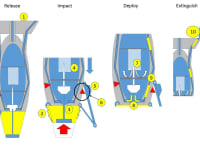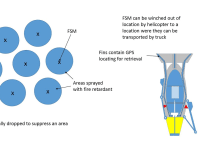In 2013 it was reported that approximately $1 billion was spent on fighting wild fires in the US (Fox News) and $10 million worth of damage in Australia (ABC News). With wild fires intensity increasing year on year the proposed design system opts to assist in tackling and reducing these impacts.
The biggest challenge aerial fire fighting have in relation to effective deployment is the larger the blaze the harder it is to effectively fly low and waterbomb the area for safety reasons.
The Fire Suppression Missile (FSM) aims to be deployed in numbers from safe altitude to target areas with raging fires that do not permit effective aerial waterbomb bombardment.
The system is based on existing extinguisher designs where a compressed gas is located within fire retardant as illustrated in image 1. The system operates in 10 steps, broken down in 4 stages.
Deployed from aircraft -
On deployment the guidance/positioning fins guide (1) the FSM to the intended area
Impact
On impact with the ground the interchangeable nose of the missile crumples (2), pushing the pin system (3) into piercing the gas canister within the fire retardant (4).
Simultaneously the outer casing folds out due to the weight (5) which provides support to the FSM, opening up the valve switch (6) and giving a rudimental location awareness (that is if the FSM happens to land next to a tree the outer casing on that side will not deploy thereby not opening the valve switch in that location, ensuring a minimal retardant is wasted on one location).
Note: if FSM landed in a position not to allow all doors to open a pressure release valve will activate to alleviate pressure build up within the FSM.
Deploy and Extinguish
As any fire extinguisher, the pierced gas cannister would release gas (7) forcing the retardant through the open pipe ports (8) and up the pipes (9) to the sprinklers (10) where the retardant is sprayed over the blazing area.
Used strategically the FSM system can be deployed to suppress an entire area as illustrated in the images.
The FSM can be retrieved thanks to a GSP system installed in the fin (area least likely to be damaged), where it can be winched up and transported to an area where it can be transported by track back to base for most parts to be recycles and readied again for deployment.
Note: Fire retardant used is non-toxic in line with retardants currently used by aerial fire bombardment
Like this entry?
-
About the Entrant
- Name:Muthomi Kiragu
- Type of entry:individual
- Patent status:pending








